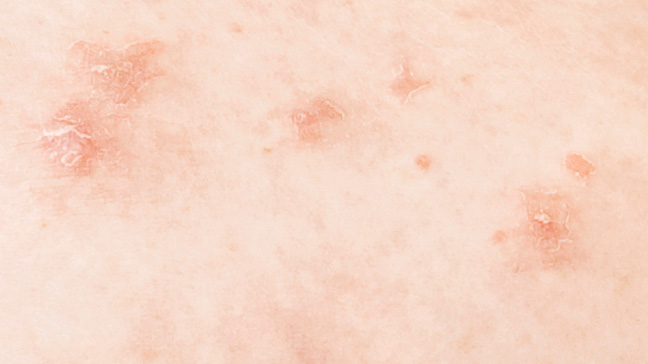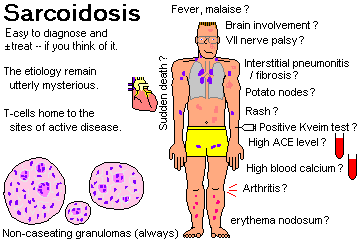Medi Services


Sarcoidosis is an inflammatory disease in which granulomas, or clumps of inflammatory cells, form in various organs. This causes organ inflammation. Sarcoidosis may be triggered by your body’s immune system responding to foreign substances, such as viruses, bacteria, or chemicals.
The areas of the body commonly affected by sarcoidosis include:
Causes and Risk Factors
·
Sarcoidosis is more common in women than in men.
·
People of African-American descent are more likely to develop
the condition.
·
People with a family history of sarcoidosis have a significantly
higher risk of getting the disease.
Sarcoidosis rarely occurs in children. Symptoms usually appear in people between the ages of 20 and 40. Symptoms
What Are the Symptoms of Sarcoidosis?
![]()
Some people with sarcoidosis don’t have any symptoms. However,
general symptoms may include:
·
fatigue
·
fever
·
weight loss
·
joint pain
·
dry mouth
·
nosebleeds
·
abdominal swelling
Symptoms vary depending on the part of your body that’s affected
by the disease. Sarcoidosis can occur in any organ, but it most commonly
affects the lungs. Lung symptoms can include:
·
a dry cough
·
shortness of breath
·
wheezing
·
chest pain around your breastbone
Skin symptoms can include:
·
skin rashes
·
skin sores
·
hair loss
·
raised scars
Nervous system symptoms can include:
·
seizures
·
hearing loss
·
headaches
Eye symptoms can include:
·
dry eyes
·
itchy eyes
·
eye pain
·
vision loss
·
a burning sensation in your eyes
·
a discharge from your eyes
Diagnosis
![]()
It can be difficult to diagnose sarcoidosis. Symptoms can be
similar to those of other diseases, such as arthritis or cancer. Your doctor
will run a variety of tests to make a diagnosis.
Your doctor will first perform a physical examination to:
·
check for skin bumps or a rash
·
look for swollen lymph nodes
·
listen to your heart and lungs
·
check for an enlarged liver or spleen
Based on the findings, your doctor may order additional
diagnostic tests:
·
A chest X-ray can be used to check for granulomas and swollen
lymph nodes.
·
A chest CT scan is an imaging test that takes
cross-sectional pictures of your chest.
·
A lung function test can help determine whether your lung
capacity has become affected.
·
A biopsy involves taking a sample of tissue that can
be checked for granulomas.
Your doctor may also order blood tests to check your kidney and
liver function.
Sarcoidosis is an inflammatory disease that affects multiple organs in the body, but mostly the lungs and lymph glands. In people with sarcoidosis, abnormal masses or nodules (called granulomas) consisting of inflamed tissues form in certain organs of the body. These granulomas may alter the normal structure and possibly the function of the affected organ(s).
The symptoms of sarcoidosis can vary greatly, depending on which organs are involved. Most patients initially complain of a persistent drycough, fatigue, and shortness of breath. Other symptoms may include:
Sarcoidosis most often occurs between 20 and 40 years of age, with women being diagnosed more frequently than men. The disease is 10 to 17 times more common in African-Americans than in Caucasians. People of Scandinavian, German, Irish, or Puerto Rican origin are also more prone to the disease. It is estimated that up to four in 10,000 people in the U.S. have sarcoidosis.
The exact cause of sarcoidosis is not known. It is a type of autoimmune disease associated with an abnormal immune response, but what triggers this response is uncertain. How sarcoidosis spreads from one part of the body to another is still being studied.
There is no single way to diagnose sarcoidosis, since all the symptoms and laboratory results can occur in other diseases. For this reason, your doctor will carefully review your medical history and examine you to determine if you have sarcoidosis. The main tools your doctor will use to diagnose sarcoidosis include:
The symptoms of sarcoidosis depend on which organs are affected, but typically include:
There's no cure for sarcoidosis, but the condition often improves without treatment within a few months or years. The symptoms aren't usually severe and don't tend to affect everyday life.
Sarcoidosis is estimated to affect about one in every 10,000 people in the UK.
It's impossible to predict how sarcoidosis will affect a person, as the condition can affect any organ and the symptoms vary widely depending on which organs are involved.
Most people with sarcoidosis develop symptoms suddenly, but they usually clear within a few months or years and the condition doesn't come back. This is known as acute sarcoidosis.
Some people don't have any symptoms at all, and the condition is diagnosed after an X-ray carried out for another reason.
A few people find their symptoms develop gradually and get worse over time, to the point where they become severely affected. Lots of granulomas may form in an organ and prevent it from working properly. This is known as chronic sarcoidosis.
Sarcoidosis most often affects the lungs, skin and/or lymph nodes (glands). Some of the typical symptoms are listed below, although someone with sarcoidosis will probably only have a few of these.
The lungs are affected in about 90% of people with sarcoidosis. This is known as pulmonary sarcoidosis.
The two main symptoms are shortness of breath and a persistent dry cough. Some people with pulmonary sarcoidosis experience pain and discomfort in their chest, but this is uncommon.
The skin is affected in about 25% of people with sarcoidosis.

This can cause tender, red bumps or patches to develop on the skin (particularly the shins), as well as rashes on the upper body.
If other organs are affected, you may also have some of the following symptoms:
The body's immune system normally fights off infections by releasing white blood cells into the blood to isolate and destroy the germs. This results in inflammation (swelling and redness) of the body tissues in that area. The immune system responds like this to anything in the blood it doesn't recognise, and dies down when the infection has been cleared.
It's thought that sarcoidosis happens because the immune system has gone into "overdrive", where the body starts to attack its own tissues and organs. The resulting inflammation then causes granulomas to develop in the organs.
There are many similar conditions, such as rheumatoid arthritis andlupus, that are caused by the body attacking its own tissues. These are collectively known as autoimmune conditions.
It's not known why the immune system behaves like this, but research is being carried out to see what triggers sarcoidosis (search clinical trials for sarcoidosis).
It's possible that some environmental factor triggers the condition in people who are already genetically susceptible to it.
Sarcoidosis can occasionally occur in more than one family member, but there's no evidence that the condition is inherited. The condition isn't infectious, so it can't be passed from person to person.
Sarcoidosis can affect people of any age, but usually starts in young adults aged between 20 and 40. It's rare in childhood.
The condition affects people from all ethnic backgrounds, but it's most common in people of African descent. It's also more common in women than men.
A number of different tests may be carried out to diagnose sarcoidosis, depending on which organs are affected.
If your symptoms suggest you have pulmonary sarcoidosis (sarcoidosis affecting the lungs), you may have a chest X-ray or a computerised tomography (CT) scan of your lungs to look for signs of the condition.
In some cases, doctors may want to examine the inside of your lungs using a long, thin, flexible tube with a light source and a camera at one end (endoscope) that's passed down your throat. A small sample of lung tissue may also be removed during this test so it can be studied under a microscope. This is known as a biopsy.
If doctors think you may have sarcoidosis affecting other organs – such as the skin, heart or eyes – scans or examinations of these areas will usually be carried out.
